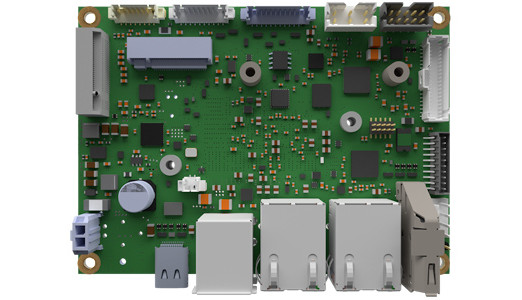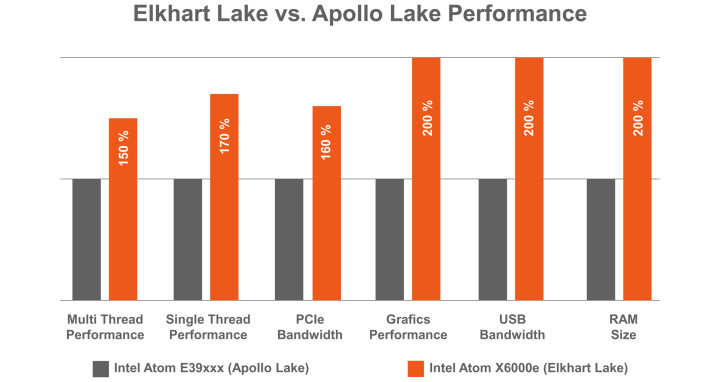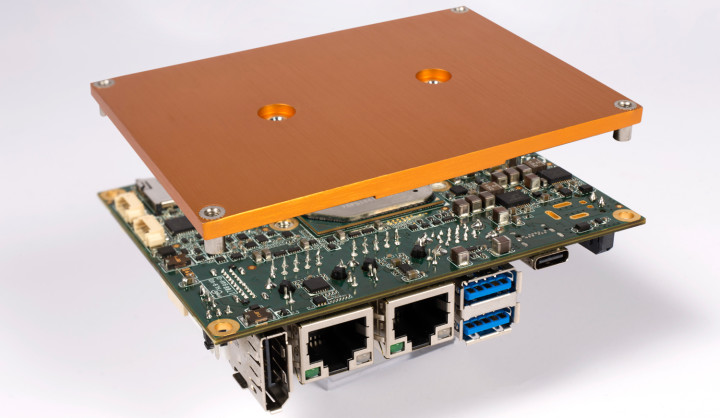Performance Boost for Edge Computing
October 29, 2020
on
on

Reliable Performance Increase with Brand New Intel Atom Boards
The new Intel Atom x6000 E Series and Intel Celeron and Pentium N & J processors (codenamed Elkhart Lake) feature graphics that are twice as fast as their predecessors and 50% more multi-thread performance on up to four cores. IPC manufacturer congatec is now making them available on the 2.5-inch Pico-ITX form factor, focusing on industrial-grade quality for the most reliable performance boost possible.
With growing digitization and the IoT trend, even the smallest edge computers are expected to meet high reliability requirements today. Start-ups, makers, and spin-offs from big industrial companies increasingly deploy them in massively distributed applications to implement their new business models and IoT-supported services. They all face a similar challenge: Their apps are approaching market-readiness but their hardware platforms, which often originate from the maker board scene, lack reliability since they were not designed for large series and harsh environments. Industrial edge computing designs, however, must provide highly reliable 24/7 service over many years. Long-term availability and rugged design are therefore critical. congatec boards have always been characterized exactly by these qualities.
(Read more below the image)

The congatec boards and modules with Intel Elkhart Lake processors convince across the entire range, offering significant performance improvements over Apollo Lake processors with higher performance per watt.
High quality even pays off in relation to performance: The conga-JC370 3.5-inch single board computer (SBC) achieved excellent design ratings in the Elektor test from October 23, 2019. This was the result of careful component selection and meticulous hardware-related software adjustment. Even under full load, the board never overheated. It also scored phenomenally well in the UserBenchmark speed test, proving that quality pays off in terms of performance gains and that, too, is important. It is well known that even the greatest performance gains of a processor can be forfeited if the final board design fails to deliver the performance boost to the end application without loss.
Elektor has not yet been able to test whether all this also applies to the new congatec Pico-ITX board. But it has every reason to assume that the conga-PA7 Pico-ITX SBC — first samples of which are already available — is another real piece of quality craftsmanship that is worth its price and ultimately even saves money, considering that a service incidence often costs significantly more than a complete board — especially, when distributed in large quantities and the journey to the affected devices alone often costs more than the boards. So, quality invariably pays off. In addition to outstanding quality, the new Pico-ITX board is scalable from 6 to 12 W and offers an outstanding feature set.
The new Pico-ITX single board computers (SBCs) are available in many configurations.
The new conga-PA7 SBC is available in eight different performance levels with Intel Atom x6000E Series processors as well as Intel Celeron and Pentium N◦&◦J processors in low-power 10◦nm technology. The Intel Atom X6425RE, Intel Atom X6414RE, or Intel Atom X6212RE versions of the new SBC even support the extended temperature range from ‑40°C to +85°C. Up to 16◦GB LPDDR4x memory, and up to 4267◦MT/s are now supported. For mission-critical applications, the in-band ECC mode can be activated in the BIOS, allowing OEMs to achieve the same level of data security with standard RAM as with expensive ECC memory. These are perfect features for rugged real-time applications. Other functions that are highly welcome for tactile Internet applications include 2x Gigabit Ethernet in combination with Intel TCC (Time Coordinated Computing), TSN (Time Synchronized Networking) and real-time support for the RTS Hypervisor from Real-Time Systems. These are massive improvements for markets such as automation and control technology, ranging from distributed process control in smart energy networks to intelligent robotics or PLCs and CNCs for discrete manufacturing. Other real-time applications can be found in test and measurement technology as well as in transport and automotive engineering applications including train and track systems or connected autonomous vehicles.
(Read more below the image)

The CPU sits on the underside of the congatec Pico-ITX SBC. Fanless passive cooling solutions dissipate the waste heat directly to the housing, resulting in a robust system with a long service life and MTBF without moving parts.
Of course, the new Pico-ITX board with Intel Atom, Celeron or Pentium processors is also perfectly suited for applications without real-time requirements, as these processors offer many additional features and functions that are essential for highly connected embedded systems. POS, kiosk and digital signage systems, or distributed gaming and lottery terminals are just a few examples of distributed installations that require M2M communication. For this purpose, all variants feature the powerful Intel Gen 11 UHD graphics, which provides up to 32 execution units and therefore effectively doubles the graphics performance compared to the previous embedded Intel Atom generation. In addition, it supports all major acceleration APIs such as DirectX 12, OpenGL 4.5, Vulkan 1.1, OpenCL 1.1 and Metal, making it predestined for 3D graphics and a wide range of GPGPU-driven applications. Video-intensive applications such as digital signage, gaming, streaming clients, and AV head-end systems benefit from the hardware-accelerated encoding and decoding of the latest codecs, such as the ultra data-efficient, albeit compute-intensive HEVC (H.265) and VP9, as well as the widely used predecessors AVC (H.264) and AV1.
The new Intel Atom x6000 E Series and Intel Celeron and Pentium N & J processors (codenamed Elkhart Lake) feature graphics that are twice as fast as their predecessors and 50% more multi-thread performance on up to four cores. IPC manufacturer congatec is now making them available on the 2.5-inch Pico-ITX form factor, focusing on industrial-grade quality for the most reliable performance boost possible.
With growing digitization and the IoT trend, even the smallest edge computers are expected to meet high reliability requirements today. Start-ups, makers, and spin-offs from big industrial companies increasingly deploy them in massively distributed applications to implement their new business models and IoT-supported services. They all face a similar challenge: Their apps are approaching market-readiness but their hardware platforms, which often originate from the maker board scene, lack reliability since they were not designed for large series and harsh environments. Industrial edge computing designs, however, must provide highly reliable 24/7 service over many years. Long-term availability and rugged design are therefore critical. congatec boards have always been characterized exactly by these qualities.
(Read more below the image)

The congatec boards and modules with Intel Elkhart Lake processors convince across the entire range, offering significant performance improvements over Apollo Lake processors with higher performance per watt.
Outstanding design quality
High quality even pays off in relation to performance: The conga-JC370 3.5-inch single board computer (SBC) achieved excellent design ratings in the Elektor test from October 23, 2019. This was the result of careful component selection and meticulous hardware-related software adjustment. Even under full load, the board never overheated. It also scored phenomenally well in the UserBenchmark speed test, proving that quality pays off in terms of performance gains and that, too, is important. It is well known that even the greatest performance gains of a processor can be forfeited if the final board design fails to deliver the performance boost to the end application without loss.Elektor has not yet been able to test whether all this also applies to the new congatec Pico-ITX board. But it has every reason to assume that the conga-PA7 Pico-ITX SBC — first samples of which are already available — is another real piece of quality craftsmanship that is worth its price and ultimately even saves money, considering that a service incidence often costs significantly more than a complete board — especially, when distributed in large quantities and the journey to the affected devices alone often costs more than the boards. So, quality invariably pays off. In addition to outstanding quality, the new Pico-ITX board is scalable from 6 to 12 W and offers an outstanding feature set.
| Processor | Cores / Threads | Clock [GHz] (Base/Boost) | CPU L2 Cache (MB) | GFE Execution Units | TDP (W) |
|||||
| Intel Atom® X6425E | 4 | 1.8 / 3.0 | 1.5 | 32 | 12 | |||||
| Intel Atom® X6413E | 4 | 1.5 / 3.0 | 1.5 | 16 | 9 | |||||
| Intel Atom® X6211E | 2 | 1.2 / 3.0 | 1.5 | 16 | 6 | |||||
| Intel Atom® X6425RE | 4 | 1.9 / - | 1.5 | 32 | 12 | |||||
| Intel Atom® X6414RE | 4 | 1.5 / - | 1.5 | 16 | 9 | |||||
| Intel Atom® X6212RE | 2 | 1.2 / - | 1.5 | 16 | 6 | |||||
| Intel® Pentium® J6425 | 4 | 1.8 / 3.0 | 1.5 | 32 | 10 | |||||
| Intel® Celeron® J6413 | 4 | 1.8 / 3.0 | 1.5 | 16 | 10 |
The new Pico-ITX single board computers (SBCs) are available in many configurations.
Edge computing in real time
The new conga-PA7 SBC is available in eight different performance levels with Intel Atom x6000E Series processors as well as Intel Celeron and Pentium N◦&◦J processors in low-power 10◦nm technology. The Intel Atom X6425RE, Intel Atom X6414RE, or Intel Atom X6212RE versions of the new SBC even support the extended temperature range from ‑40°C to +85°C. Up to 16◦GB LPDDR4x memory, and up to 4267◦MT/s are now supported. For mission-critical applications, the in-band ECC mode can be activated in the BIOS, allowing OEMs to achieve the same level of data security with standard RAM as with expensive ECC memory. These are perfect features for rugged real-time applications. Other functions that are highly welcome for tactile Internet applications include 2x Gigabit Ethernet in combination with Intel TCC (Time Coordinated Computing), TSN (Time Synchronized Networking) and real-time support for the RTS Hypervisor from Real-Time Systems. These are massive improvements for markets such as automation and control technology, ranging from distributed process control in smart energy networks to intelligent robotics or PLCs and CNCs for discrete manufacturing. Other real-time applications can be found in test and measurement technology as well as in transport and automotive engineering applications including train and track systems or connected autonomous vehicles.(Read more below the image)

The CPU sits on the underside of the congatec Pico-ITX SBC. Fanless passive cooling solutions dissipate the waste heat directly to the housing, resulting in a robust system with a long service life and MTBF without moving parts.
Significantly more graphics than before
Of course, the new Pico-ITX board with Intel Atom, Celeron or Pentium processors is also perfectly suited for applications without real-time requirements, as these processors offer many additional features and functions that are essential for highly connected embedded systems. POS, kiosk and digital signage systems, or distributed gaming and lottery terminals are just a few examples of distributed installations that require M2M communication. For this purpose, all variants feature the powerful Intel Gen 11 UHD graphics, which provides up to 32 execution units and therefore effectively doubles the graphics performance compared to the previous embedded Intel Atom generation. In addition, it supports all major acceleration APIs such as DirectX 12, OpenGL 4.5, Vulkan 1.1, OpenCL 1.1 and Metal, making it predestined for 3D graphics and a wide range of GPGPU-driven applications. Video-intensive applications such as digital signage, gaming, streaming clients, and AV head-end systems benefit from the hardware-accelerated encoding and decoding of the latest codecs, such as the ultra data-efficient, albeit compute-intensive HEVC (H.265) and VP9, as well as the widely used predecessors AVC (H.264) and AV1. Read full article
Hide full article



Discussion (0 comments)